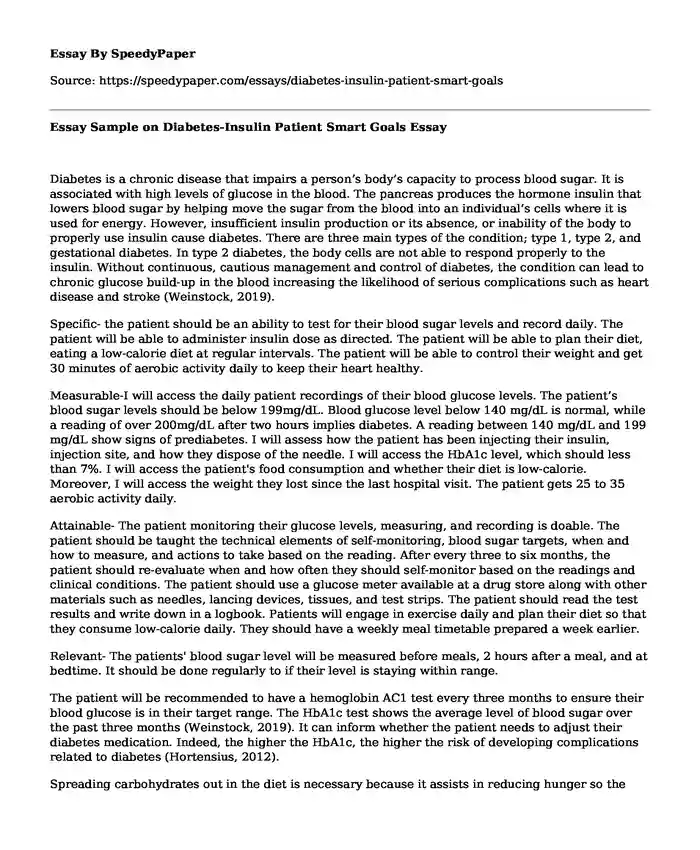
| Essay type: | Process essays |
| Categories: | Goal Knowledge Diabetes |
| Pages: | 3 |
| Wordcount: | 706 words |
Diabetes is a chronic disease that impairs a person’s body’s capacity to process blood sugar. It is associated with high levels of glucose in the blood. The pancreas produces the hormone insulin that lowers blood sugar by helping move the sugar from the blood into an individual’s cells where it is used for energy. However, insufficient insulin production or its absence, or inability of the body to properly use insulin cause diabetes. There are three main types of the condition; type 1, type 2, and gestational diabetes. In type 2 diabetes, the body cells are not able to respond properly to the insulin. Without continuous, cautious management and control of diabetes, the condition can lead to chronic glucose build-up in the blood increasing the likelihood of serious complications such as heart disease and stroke (Weinstock, 2019).
Specific- the patient should be an ability to test for their blood sugar levels and record daily. The patient will be able to administer insulin dose as directed. The patient will be able to plan their diet, eating a low-calorie diet at regular intervals. The patient will be able to control their weight and get 30 minutes of aerobic activity daily to keep their heart healthy.
Measurable-I will access the daily patient recordings of their blood glucose levels. The patient’s blood sugar levels should be below 199mg/dL. Blood glucose level below 140 mg/dL is normal, while a reading of over 200mg/dL after two hours implies diabetes. A reading between 140 mg/dL and 199 mg/dL show signs of prediabetes. I will assess how the patient has been injecting their insulin, injection site, and how they dispose of the needle. I will access the HbA1c level, which should less than 7%. I will access the patient's food consumption and whether their diet is low-calorie. Moreover, I will access the weight they lost since the last hospital visit. The patient gets 25 to 35 aerobic activity daily.
Attainable- The patient monitoring their glucose levels, measuring, and recording is doable. The patient should be taught the technical elements of self-monitoring, blood sugar targets, when and how to measure, and actions to take based on the reading. After every three to six months, the patient should re-evaluate when and how often they should self-monitor based on the readings and clinical conditions. The patient should use a glucose meter available at a drug store along with other materials such as needles, lancing devices, tissues, and test strips. The patient should read the test results and write down in a logbook. Patients will engage in exercise daily and plan their diet so that they consume low-calorie daily. They should have a weekly meal timetable prepared a week earlier.
Relevant- The patients' blood sugar level will be measured before meals, 2 hours after a meal, and at bedtime. It should be done regularly to if their level is staying within range.
The patient will be recommended to have a hemoglobin AC1 test every three months to ensure their blood glucose is in their target range. The HbA1c test shows the average level of blood sugar over the past three months (Weinstock, 2019). It can inform whether the patient needs to adjust their diabetes medication. Indeed, the higher the HbA1c, the higher the risk of developing complications related to diabetes (Hortensius, 2012).
Spreading carbohydrates out in the diet is necessary because it assists in reducing hunger so the patient will not overeat (Hortensius, 2012).
Aerobic activity improves cardiorespiratory fitness, reduces insulin resistance, and increases lipid levels, and endothelial function (Hortensius, 2012).
Timely- The patient blood sugar level will be within normal in the next four months. Patients will reduce or maintain their weight to the normal weight level within four months; their body mass index should decrease or be maintained.
References
Hortensius, J., Kars, M. C., Wierenga, W. S., Kleefstra, N., Bilo, H. J., & van der Bijl, J. J. (2012). Perspectives of patients with type 1 or insulin-treated type 2 diabetes self-monitor blood glucose: a qualitative study. BMC Public Health, 12(1), 167. https://link.springer.com/article/10.1186/1471-2458-12-167
Weinstock, R. S. (2019). Patient education: Self-monitoring of blood sugar in diabetes (Beyond the Basics). Portal Update [08/05/2019]. Disponível em: Acesso em, 10(10). https://virtualgynecology.com/wp-content/uploads/2020/05/Patient-education_-Self-monitoring-of-blood-sugar-in-diabetes-Beyond-the-Basics-UpToDate.pdf
Cite this page
Essay Sample on Diabetes-Insulin Patient Smart Goals. (2023, Nov 05). Retrieved from https://speedypaper.net/essays/diabetes-insulin-patient-smart-goals
Request Removal
If you are the original author of this essay and no longer wish to have it published on the SpeedyPaper website, please click below to request its removal:
- Essay Sample on The Role of Family Nursing Practitioners
- Paper Example on Contribution Factors for Occurrences of Falls
- Essay Example. Another Strategy for Addressing the Evaluation Challenge Identified by My Colleague
- Free Essay: Dangers of American Football
- Drugs and Health - Free Essay Example
- Essay Example on A Case Analysis on Patient's Spiritual Needs
- Free Paper Example on The Role of Public Health
Popular categories




